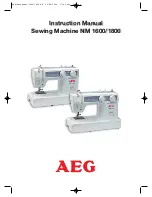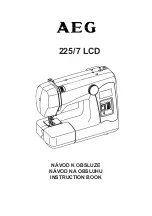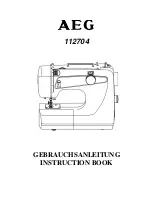
22
3.10 Safety clutch
3.10.1 Description
The machine is provided with a safety clutch which enables the turning
through of the lower belt wheel (1) on the hub of the lower shaft (2),
when the hook is blocked. This blocking occurs due to the penetration
of thread into the hook path. With current running, this clutch should
not disengage during the normal running. The mutual connection of
the belt wheel (1) with the hub is enabled by the pins (5) which fit with
their conic ends into the holes of the belt wheel. The pins are pushed by
the springs (4). Putting the clutch in its working position, eventual
checking its correct position are to be done in blocking the hook using
a screwdriver and in turning a bit the handwheel.
3.10.2 Setting the disengaging moment
Caution! Danger of injury!
Switch off the main switch! Before starting the setting
operation, wait until the motor stops!
The moment of 8 to 9 Nm is correctly set, when the screwed in adjusting
screws (3) come to lie 0.5 to 1.5 mm under the face of the hub (2).
When the clutch disengages during a normal run, the screws are to be
turned by one thread to the right and a test is to be done during the
running. In an opposite case, when the hook is blocked, but the clutch
does not disengage, the disengaging moment of the clutch is to be
reduced in turning the screws to the left.
Caution!
The clutch guarantees only one mutual position of
the hub of the lower shaft (2) and that of the belt
wheel (1). No checking according to the gauge marks is
needed. Putting the clutch out of operation by excessive tightening
of the screws (3) can cause, when blocking the hook, the destruction
of the gear within the drive of the hook.
3.11 Indented belt transmission
3.11.1 Setting the tensioning roller of the
indented belt
The optimum tension of the indented belt (1) is attained in setting the
tensioning roller (2) in such position, when the roller applies the
pressure of F = 20 N against the belt. The roller must be side set in such
a way that the edge of the indented belt does not overlap over the edge
of the roller.
Caution! Danger of injury!
Switch off the main switch! Before starting the setting
operation, wait until the motor stops!
- Remove the handwheel and the belt guard, remove the V-belt.
- Unlock the fastening of the loop, on which the roller (2) is mounted
in such a way that the loop turns freely.
- Lift the roller (2) upwards and, thereafter, using the dynamo-meter
(4), pull horizontally the roller in applying the force of 2O N. In this
position, tighten the fastening screw (3).
- Check the side shifting of the roller.
1
2
3
4
5
1
4
3
2










































